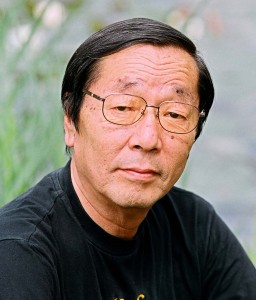Masaru Emoto facts for kids
Quick facts for kids
Masaru Emoto
江本勝 |
|
|---|---|
 |
|
| Born | July 22, 1943 Yokohama, Japan
|
| Died | October 17, 2014 (aged 71) Japan
|
| Education | Yokohama Municipal University |
| Spouse(s) | Kazuko Emoto |
Masaru Emoto (July 22, 1943 – October 17, 2014) was a Japanese author. He believed that human thoughts and feelings could affect the way water looks. He wrote a popular book called The Hidden Messages in Water in 2004. In this book, he shared his ideas about water reacting to positive words and thoughts. He also suggested that polluted water could become clean through prayer.
Starting in 1999, Emoto published several books called Messages from Water. These books showed photos of ice crystals. They also described experiments, like one with rice in water over 30 days.
Contents
About Masaru Emoto
Emoto was born in Yokohama, Japan. He studied International Relations at Yokohama Municipal University. After college, he worked for a newspaper. Later, he started his own company called International Health Medical in 1986.
In 1989, he began selling a device called the "Vibration-o-Meter." He used this device to study "vibrations" in the body. He also became the President Emeritus of the International Water For Life Foundation. This was a non-profit group in the United States. In 1992, he earned a degree in Alternative Medicine.
Emoto's Ideas About Water
Emoto believed that water was like a "blueprint" for our world. He thought that our emotions and "energies" could change water's physical shape. He did experiments with water crystals to show this.
Water Crystal Experiments
In his experiments, Emoto put water into different glasses. He then exposed each glass to various things. These included words, pictures, or even music. After this, he would freeze the water.
He then took photos of the ice crystals using a microscope. Emoto claimed that water exposed to positive words or thoughts made beautiful ice crystals. But water exposed to negative intentions created "ugly" or distorted ice shapes.
Water Sources and Changes
Emoto also thought that water from different places made different ice structures. For example, he said that water from a mountain stream made lovely geometric designs when frozen. However, water from polluted sources created messy, random ice shapes. He believed these changes could be fixed by exposing water to ultraviolet light or certain electromagnetic waves.
In 2008, Emoto shared his findings in a journal called Journal of Scientific Exploration. He worked with other researchers on this project.
See also
- Water memory
- Polywater
- Water (2006 film)
- Pseudoscience
- Quantum mysticism

